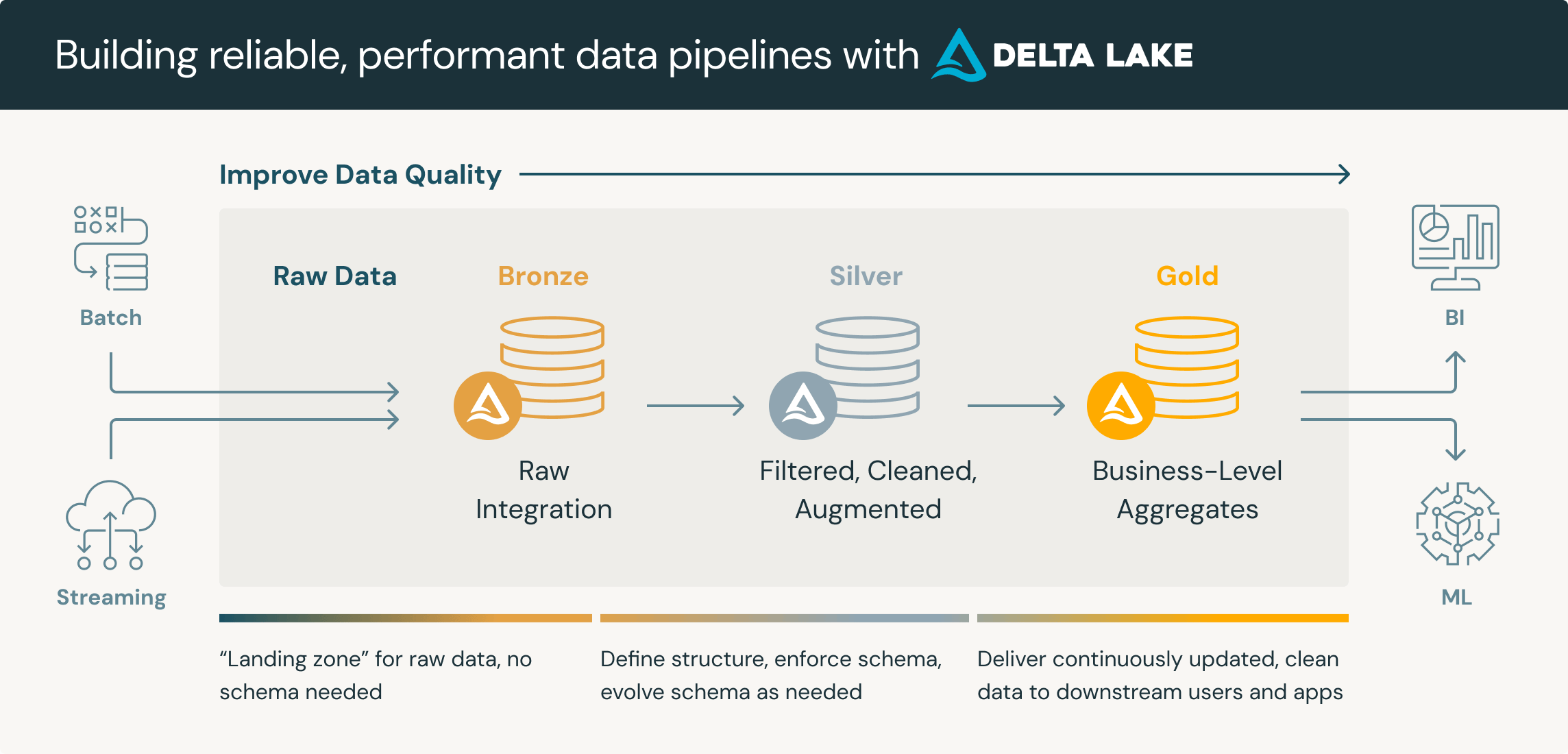Understanding Medallion Architecture: A Comprehensive Guide
In today’s data-driven world, organizations face the challenge of managing vast volumes of diverse data coming from multiple sources. The Medallion Architecture offers a structured way to tackle this challenge by organizing data into layered stages, gradually refining it from its raw form to a business-ready state. Often referred to as a multi-hop architecture, this pattern is especially popular in modern data lakehouse environments where the flexibility of a data lake meets the reliability of a data warehouse.
In this post, we will explore the key concepts of Medallion Architecture, explain each layer in detail, and discuss where and how it can be applied.
What Is Medallion Architecture?
Medallion Architecture is a data design pattern that organizes data processing into multiple, logical layers. The goal is to incrementally improve data quality and structure as data flows through these layers. The three primary layers are:
- Bronze: Raw, unfiltered data.
- Silver: Cleansed and conformed data.
- Gold: Aggregated, business-level data ready for consumption.
By separating the data processing pipeline into these layers, organizations can ensure robust data governance, maintain auditability, and support both exploratory analytics and mission-critical reporting.
The Layers of Medallion Architecture
Bronze Layer: The Raw Data Zone
The Bronze layer is the foundation of the Medallion Architecture. Here, data is ingested from various external sources and stored in its original, unaltered format. Key characteristics include:
- Raw Ingestion: Data is captured as-is (e.g., CSV files, JSON logs, streaming data).
- Metadata Enrichment: Additional columns, such as load timestamp, source ID, or processing status, are often added.
- Historical Archive: Since no major transformations are applied, this layer serves as a robust archive for data lineage and reprocessing.
Example Use Case:
A retail company collects transaction logs from multiple point-of-sale systems. These logs are loaded into the Bronze layer to preserve the exact state of the data as received, ensuring that every detail is available for auditing or troubleshooting.
Silver Layer: Cleansing and Conforming
Once raw data is stored, it needs to be cleaned and standardized. The Silver layer takes data from the Bronze layer and applies a series of transformations to:
- Cleanse Data: Remove duplicates, filter out corrupt records, and handle missing values.
- Standardize Formats: Convert data into a consistent schema and format.
- Integrate Multiple Sources: Merge and reconcile data from different sources to create a unified view.
Example Use Case:
Continuing with the retail example, data from different stores is merged and cleansed in the Silver layer. Customer records are deduplicated, and inconsistencies (such as varying date formats) are resolved, resulting in a consistent view of transactions and customer interactions.
Sample Transformation Code (PySpark):
# Read raw data from Bronze layer
bronze_df = spark.read.format("delta").load("/lake/bronze/transactions")
# Cleanse and standardize data for the Silver layer
silver_df = bronze_df.filter("amount IS NOT NULL") \
.withColumn("transaction_date", to_date(col("transaction_date"), "MM-dd-yyyy")) \
.dropDuplicates(["transaction_id"])
# Write the cleansed data to the Silver layer
silver_df.write.format("delta").mode("overwrite").save("/lake/silver/transactions")
Gold Layer: Business-Ready Aggregated Data
The final stage in the Medallion Architecture is the Gold layer, where data is further refined and optimized for direct business consumption. This layer focuses on:
- Aggregation and Enrichment: Applying business logic, creating summary tables, and performing complex calculations.
- Optimized for Analytics: Data models in the Gold layer are often denormalized (e.g., star schema) for fast query performance.
- Tailored Views: The data is arranged to serve specific use cases like dashboards, reporting, and machine learning applications.
Example Use Case:
In the retail scenario, the Gold layer could consist of sales summaries by region, time-period, or product category. Business users and analysts can directly query these tables to generate KPIs and performance reports without worrying about the underlying data complexities.
Sample Aggregation Code (SQL):
-- Create a Gold table for aggregated sales metrics
CREATE TABLE gold_sales_summary AS
SELECT
store_id,
date(transaction_date) as sale_date,
SUM(amount) as total_sales,
COUNT(transaction_id) as transactions_count
FROM silver.transactions
GROUP BY store_id, date(transaction_date);
Where Can Medallion Architecture Be Applied?
Medallion Architecture is versatile and can be applied in various scenarios, including:
- Data Lakehouses: Combining the scalability of data lakes with the reliability of data warehouses.
- Business Intelligence (BI): Providing clean, aggregated data for dashboards and reports.
- Machine Learning: Supplying high-quality, processed data to train robust ML models.
- Data Warehousing: Structuring ETL/ELT pipelines to support operational and analytical workloads.
- Data Governance: Enhancing traceability, auditability, and data quality across the organization.
Key Principles and Benefits
- Incremental Data Refinement: Each layer builds upon the previous one, progressively enhancing data quality.
- Data Governance and Auditability: Keeping raw data intact in the Bronze layer ensures that data lineage and historical context are preserved.
- Scalability and Flexibility: Independent layers allow teams to scale processing and storage as needed, accommodating both batch and streaming data.
- Performance Optimization: The Gold layer’s design—often using star schema or other optimized data models—ensures fast query performance for business users.
- Single Source of Truth: Consistent data across layers builds trust and supports informed decision-making.
Conclusion
Medallion Architecture offers a clear and methodical framework for managing the data lifecycle—from raw ingestion to refined, business-ready analytics. By leveraging the Bronze, Silver, and Gold layers, organizations can ensure that data remains accurate, auditable, and scalable. Whether you’re building a data lakehouse, designing a data warehouse, or implementing a BI solution, adopting this layered approach can simplify your data pipelines and enhance overall data quality.
Have you implemented Medallion Architecture in your projects?
Happy Data Engineering!
